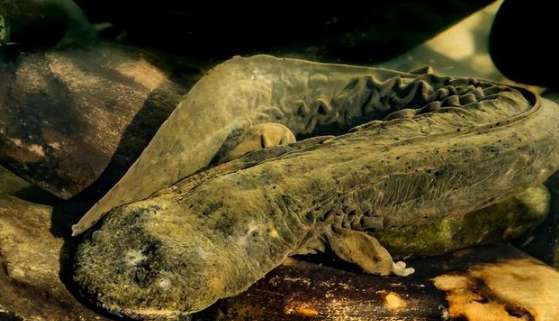For the past eight years, Virginia Tech scientists have been studying the behavioral patterns of the American giant salamander. But they felt that the species they had studied for so long had become a bit unfamiliar, and they had behaved in a very unnatural way: preying on their own cubs.

The American giant salamander
The American giant salamander is a cryptozoan. The giant salamanders in this genus all look similar, such as the Chinese giant salamander and the Japanese giant salamander. They are both naked, dim-colored, predators that ambush in fresh water. However, the American giant salamander still has unique identification features. Their body length is up to 0.74 meters and they weigh 1.8-2.3 kilograms. Compared with other relatives, it has a pair of gill slits or a gill slit on the left side, and its color is brown or gray. Mainly, the size is also smaller.

They are distributed in the eastern United States and inhabit rivers in southwestern Virginia. of cold waters and is believed to be the largest salamander in North America. The American giant salamander prefers rivers and streams with slow flow, temperatures below 20 degrees, and abundant aquatic plants. Although they look silly, they are actually ferocious carnivorous nocturnal predators. While waiting for prey, as long as prey passes by, they will open their mouths wide and swallow it whole, and then let the stomach acid slowly digest it.
Although it is very ferocious to prey, to humans, the American giant salamander is the so-called "ferocious". Although it is very violent, it is not really a deterrent, and some are even funny. Many people poach them as exotic pets, or sell them to some areas as food. In addition, environmental damage has led to the reduction of its habitat. In 2012, the American giant salamander was listed as a near-threatened species by the World Conservation Union (IUCN). .
Abnormal behavior of American giant salamanders
Normally, male American giant salamanders actually eat their offspring, but they eat about 14% of the offspring that have a very low chance of survival. They will guard the eggs for several months before then. The behavior of predators is not uncommon among wild animals, and it makes the chances of survival very low.These descendants will be exposed in the wilderness soon, so it is better to deal with them yourself.

But the behavior of American giant salamanders in eating their offspring has increased in recent years. It has become so frequent that almost 30% of the offspring will be eaten by male giant salamanders, including some healthy and strong offspring. This is very abnormal! Their tendency to prey on young has tripled, puzzling scientists at Virginia Tech.
After a period of research and observation, scientists found that if male salamanders live in areas affected by deforestation, they are more likely to eat their young, from which they concluded: water caused by deforestation Chemical changes may deplete the axolotl's food supply, causing this behavioral shift.

Over the past 50 years, giant salamanders have begun to prey on their young. The number of American giant salamanders is declining. In the past, it was mainly due to poaching. After legal restrictions, the main reason for the decline of American giant salamanders is climate change and deforestation. Scientists worry that the increasingly common practice of giant salamanders eating their young will speed up the extinction of the species.
Postscript
William Hopkins, an ecologist at Virginia Tech University and the main person in charge of the experiment to observe the American giant salamander, believes that such behavioral changes once again warn humans about the impact of environmental changes on wild animals. Influence. There may be other species with similar behavioral changes, which may explain the declines in many species.